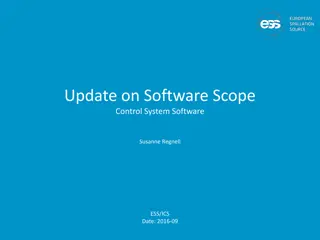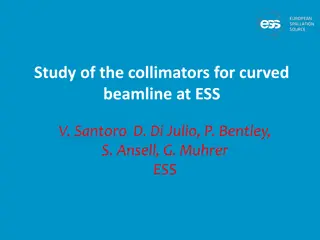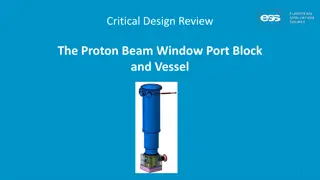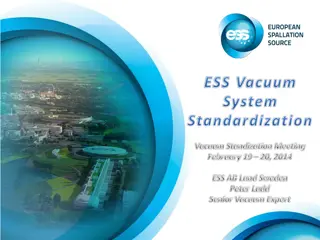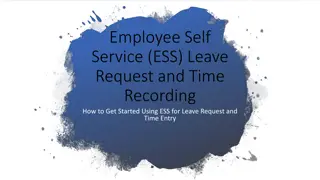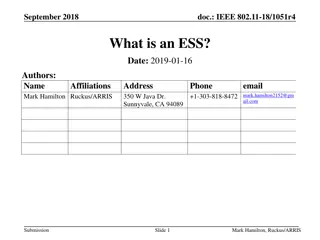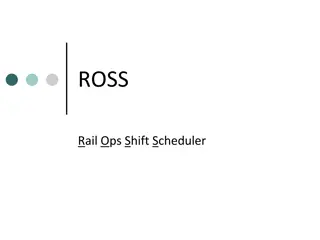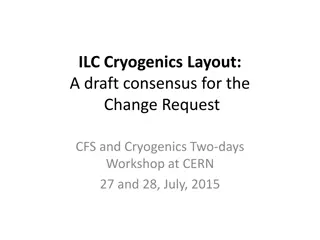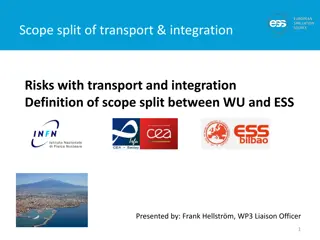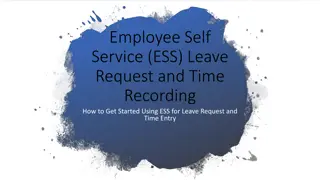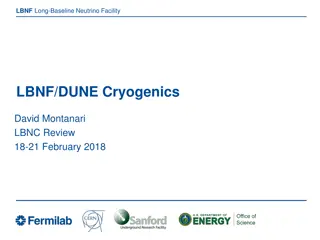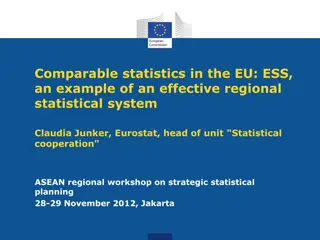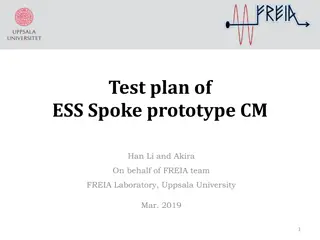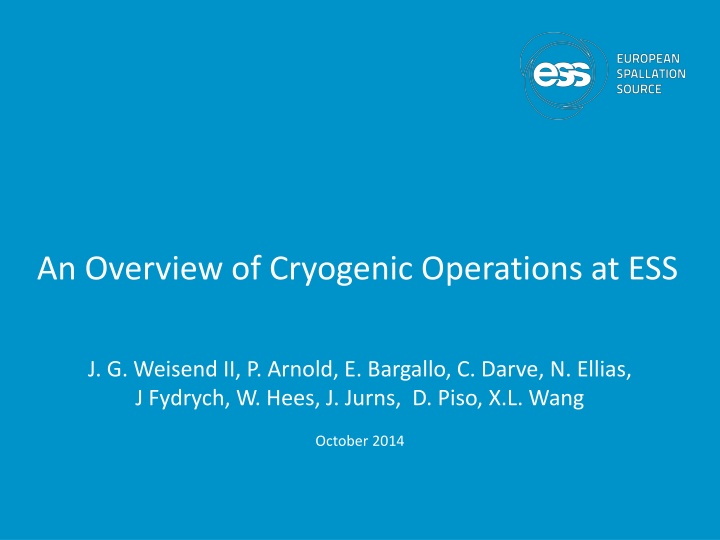
Cryogenic Operations at ESS Overview
Explore the detailed overview of cryogenic operations at ESS including the facility's goals, applications of cryogenics, cryogenic systems, and accelerator cryogenics. Learn about the advanced technologies and cooling processes used at ESS for neutron-based research in various scientific fields.
Download Presentation

Please find below an Image/Link to download the presentation.
The content on the website is provided AS IS for your information and personal use only. It may not be sold, licensed, or shared on other websites without obtaining consent from the author. If you encounter any issues during the download, it is possible that the publisher has removed the file from their server.
You are allowed to download the files provided on this website for personal or commercial use, subject to the condition that they are used lawfully. All files are the property of their respective owners.
The content on the website is provided AS IS for your information and personal use only. It may not be sold, licensed, or shared on other websites without obtaining consent from the author.
E N D
Presentation Transcript
An Overview of Cryogenic Operations at ESS J. G. Weisend II, P. Arnold, E. Bargallo, C. Darve, N. Ellias, J Fydrych, W. Hees, J. Jurns, D. Piso, X.L. Wang October 2014
Outline Introduction to ESS Cryogenics at ESS Operating Scenarios Controls Staffing Reliability Strategy Summary October 2014 Accelerator Ops 2014 - J.G. Weisend II 2
Introduction to ESS The goal of ESS is to provide a spallation based neutron source significantly more powerful than existing sources: 30 - 100 times brighter than ILL and 5 times more powerful than SNS This facility will enable neutron based research in a wide range of fields including: materials science, condensed matter and biomedical studies October 2014 Accelerator Ops 2014 - J.G. Weisend II 3
ESS Overview 5 Times more powerful than SNS 30 -100 times brighter than ILL October 2014 Accelerator Ops 2014 - J.G. Weisend II 4
Applications of Cryogenics at ESS Cooling for the cryomodules (2 K, 4.5 300 K and 40 K) Cooling for the Target supercritical H2Moderator (16.5 K) Liquid Helium and Liquid Nitrogen for the Neutron Instruments Cooling for the cryomodule test stand (2 K, 4.5 300 K and 40 K) This is accomplished via 3 separate cryoplants October 2014 Accelerator Ops 2014 - J.G. Weisend II 5
ESS Cryogenic System October 2014 Accelerator Ops 2014 - J.G. Weisend II 6
Accelerator Cryogenics Bulk of acceleration is carried out via 3 classes of SRF cavities: Spoke, Medium ( = 0.67 ) Beta Elliptical and High ( = 0.86) Beta Elliptical No superconducting magnets in the accelerator. There are some in the instruments Cavities operate at 2 K with a 40 50 K thermal shield Power coupler cooling from 4.2 K to 300 K Accelerator lattice permits an 14 additional cryomodules to compensate for lower than expected cryomodule gradients (Stage 2) October 2014 Accelerator Ops 2014 - J.G. Weisend II 7
ESS Accelerator Cryoplant (ACCP) Provides cryogenic cooling to Cryomodules 13 Spoke and 30 Elliptical (Stage 1) Sized to allow an additional 14 Elliptical Cryomodules for design contingency (Stage 2) Allows for number of operating modes Connected to the cryomodules via a cryogenic distribution system High availability and turn down capability are important features Compressor heat is absorbed by Lund District Heating System (unique ESS feature) October 2014 Accelerator Ops 2014 - J.G. Weisend II 8
ACCP Capacities October 2014 Accelerator Ops 2014 - J.G. Weisend II 9
Cryogenic Distribution System Allows warm up and cool down of one or more cryomodules w/o affecting remaining cryomodules Connection between distribution line & cryomodule is done via fixed connections Separate isolation vacuums in the distribution lines and cryomodules Operating modes defined Conceptual design complete Detailed design and production via IKC or commercial contract will start by Q1 2015 Cryogenic Distribution System must be complete and installed by December of 2017 October 2014 Accelerator Ops 2014 - J.G. Weisend II 10
L inac C D S function and layouts Cryogenic System of the Optimus Linac Linac Cryoplant Cryogenic Distribution Line (310 m) comprising 43 valve boxes Cryogenic Transfer Line (75 m) Auxiliary process lines Endbox Splitting box 21 High Beta Cryomodules (174 m) 9 Medium Beta Cryomodules (75 m) 13 Spoke Cryomodules (54 m) Superconducting section of the Optimus Linac (303 m) October 2014 Accelerator Ops 2014 - J.G. Weisend II 11
Elliptical Cryomodules in ESS Tunnel October 2014 Accelerator Ops 2014 - J.G. Weisend II 12
Target Moderator Cryoplant Cools the Supercritical H2 neutron moderators that surround the target Provides 20 kW of cooling at 16.5 K via GHe to the He/supercritical H2heat exchanger Moderator design is still under development and final heat load won t be known until late 2014 ESS Target Division responsible for the supercritical H2system Compressor heat is absorbed by Lund District Heating System (unique ESS feature) Cryoplant should be ordered in 2016 and fully commissioned by December of 2018 October 2014 Accelerator Ops 2014 - J.G. Weisend II 13
Test and Instruments Cryoplant Provides cooling at 2 K, 40 K and 4.5 K liquefaction for elliptical cryomodule testing 2 K operation done via warm vacuum pumps During ESS operations, provides up to 7500 l per month of LHe to the instruments Helium is recovered, purified and reliquefied Sufficient LHe storage planned to allow several weeks of Science Ops in the case of cryoplant failure October 2014 Accelerator Ops 2014 - J.G. Weisend II 14
Test and Instruments Cryoplant Capacity and Status The plant will produce: 75 W @ 2 K, 422 W @ 40 K 0.4 g/s at 4.5 K for coupler cooling A plant this size exceeds the 7500 l / month liquefaction requirement Cryoplant should be ordered in August 2015 and fully commissioned by July 2017 October 2014 Accelerator Ops 2014 - J.G. Weisend II 15
Helium Recovery and Storage The ESS goal is to recover, purify and reuse as much He as possible ACCP and TICP cryoplants will share a common gas system while TMCP has separate storage that can be cross connected The system will include a separate cryogenic purifier Systems will be provided by IKC or separate contracts Expected He Storage Capacities: LHe GHe (20 Bar) 1000 m3 - sufficient to hold all the linac inventory GHe (200 Bar) 12 m3 - Instrument He storage 20 m3(Includes storage for second fill of linac) 5 m3 (Backup for Instruments He) October 2014 Accelerator Ops 2014 - J.G. Weisend II 16
Operation Planning Cryogenic plants will be commissioned separately, but will eventually be operated simultaneously. When operating, cryogenic plants will run 24/7 Once cryomodule testing is complete (~ 2021) TICP will only be periodically operated to create LHe for instruments Modern automated cryogenic plants have been shown to operate continuously and reliably without the constant presence of an operator Staffing is planed to allow 24/7 presence of Cryogenic Operators/Technicians on site. However, after sufficient commissioning and preliminary operations time ( ~ 2 years) , it is expected that cryoplant operators will only be called in outside normal business hours in case of problems. Once cryoplant commissioning is complete, Accelerator Operators in the ESS Control room will monitor the cryogenic system & make routine adjustments with Cryogenic Operators addressing problems & making operating mode changes (warm up, cool down etc.) October 2014 Accelerator Ops 2014 - J.G. Weisend II 17
Operation Planning Instruments will need access to LN2and LHe 24/7 LHe deliveries will be done by the STS Group. This will normally be done on day shift but on call staff will be available for exceptional cases. Our goal is to recover all the helium. Automated He recovery system does not require constant staff presence. LN2supplied to large dewars on site by commercial vendor and distributed to users via local LN2distribution systems or smaller dewars. GN2is vented to atmosphere. October 2014 Accelerator Ops 2014 - J.G. Weisend II 18
Operation Planning ESS plans two long shut downs per year (6 weeks in winter & 10 weeks in summer) Cryoplants during these periods will be shut down or possibly operating at 40 K standby (ACCP) These shut downs are sufficient for routine large scale maintenance on the cryogenic systems During unscheduled repair periods, cryoplants will remain at their nominal operating conditions unless a cryogenic component needs repair Unnecessary thermal cycling will be avoided (individual cryomodules can be thermal cycled for in situ repair) Replacement or addition of entire cryomodules is best done during long shut downs when the cryogenic system is warm The majority of preventive maintenance for the Cryogenic System concerns the 300 K portion and much of this can be done without interrupting cryogenic operations October 2014 Accelerator Ops 2014 - J.G. Weisend II 19
Tentative ESS Operating Schedule during Steady State Operations (2026 & Beyond) October 2014 Accelerator Ops 2014 - J.G. Weisend II 20
Linac & Cryomodule Operating Modes October 2014 Accelerator Ops 2014 - J.G. Weisend II 21
Cryogenic Modes for Linac and Cryomodules October 2014 Accelerator Ops 2014 - J.G. Weisend II 22
General Controls Strategy The ACCP control strategy shall be based in EPICS to provide monitoring and operational capabilities for the ACCP. Functions for supervisory controls and batch operations shall be running in the EPICS process controller (EPICS IOC) for a fully automated operation of the ACCP. PLCs shall be used for all functions with substantial technical safety requirements and deterministic logic for controlling the process. Each PLC shall have an interface to the EPICS process controller (IOC). The logic shall be split between EPICS IOC and PLCs in such a way that boot, restart or breakdowns of EPICS IOC, HMIs, etc. do not affect the control of the cryogenic process . Cryoplant vendors For ACCP and TMCP produce all control programming including EPICS programming & HMIs for commissioning ICS will provide PLC standards, EPICS backbones, utilities and integration support ICS may also provide controls programming for TICP plant & ancillary cryogenic systems (recovery, gas management etc.) Some controls programming may be done by in kind contributors October 2014 Accelerator Ops 2014 - J.G. Weisend II 23
General Controls Strategy October 2014 Accelerator Ops 2014 - J.G. Weisend II 24
Planned Staffing During Construction & Installation: 7 Engineers ( Cryogenic, Mechanical, Controls) 3 Operators / Technicians Support from other Work Packages (Electrical, Water Cooling, Vacuum etc.) During Commissioning and Operations 6 Engineers 8 - Operators/Technicians Support from other operating groups (accelerator, Conventional Facilities etc.) October 2014 Accelerator Ops 2014 - J.G. Weisend II 25
Staff Development Almost all engineers required for construction phase have been hired with remainder to arrive in 2015 Current engineering staff will transition to operations duties and support in 2018 2019 Operators will perform maintenance & support roles (e.g. LHe distribution) They may be available to support vacuum techs or other accelerator operations Operators and technicians will start to be hired in 2016 to allow training and participation in installation & commissioning Operators & technicians are expected to be hired locally Training of new staff will include classroom (LU activities), on the job and possible secondment to similar existing facilities We are investigating the development of simulation software for the ACCP to assist in training October 2014 Accelerator Ops 2014 - J.G. Weisend II 26
RAMI analysis of the cryoplant Purposes of the analysis Reliability and availability considerations in the tendering phase Contribution of the cryoplant to the overall availability and reliability of ESS Methodology followed Components reliability and maintainability provided by companies Failure mode analysis (components with their functions, possible failures and the consequences) Availability and reliability modeling Results to see differences between the different proposals Iterative process with more detail in the design, more accurate assumptions and models to: Analyze the design and propose changes and recommendations if it does not fulfill the requirements Foresee preventive and corrective maintenance actions, spares and tools 27
Summary Cryogenics will play a major role in ESS and affects the accelerator, target and instruments projects Work is well underway A very skilled team has been assembled Sizable procurements will start in 2015 An Integrated Controls strategy has been developed Detailed reliability studies are underway Civil construction has started Once full operations start ( ~ 2023) routine operation of cryoplants will be covered by accelerator operators Current plan allows 24/7 coverage by cryogenics operators Challenges include: Staff development Meeting reliability goals Helium conservation October 2014 Accelerator Ops 2014 - J.G. Weisend II 28



